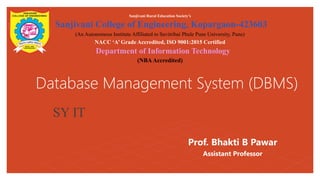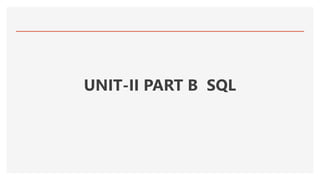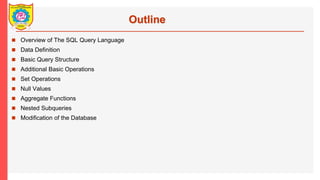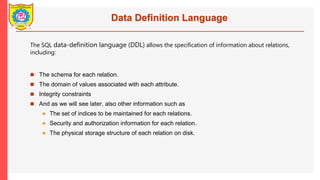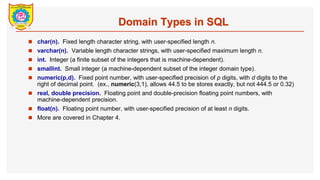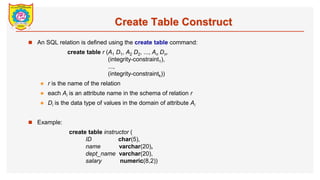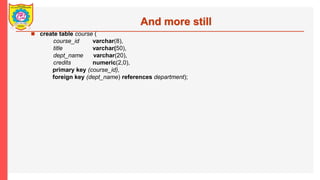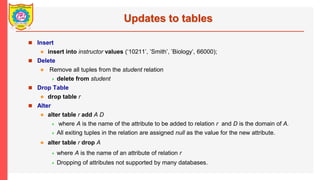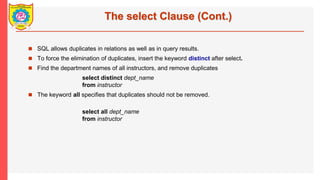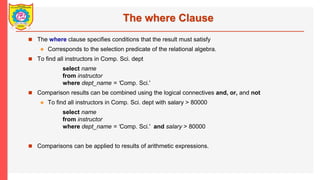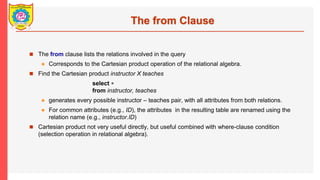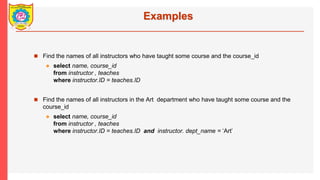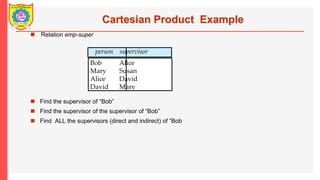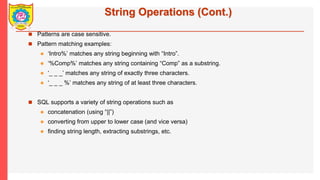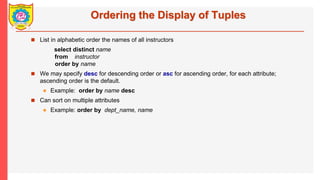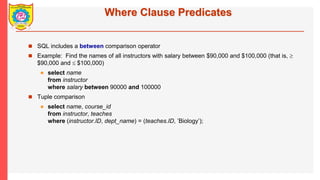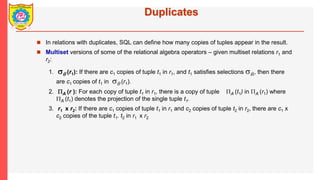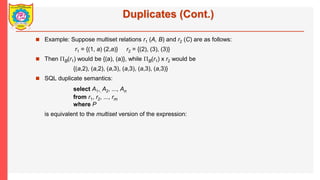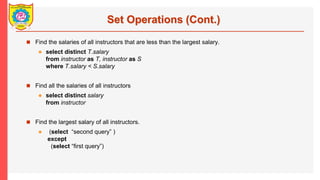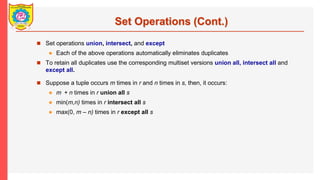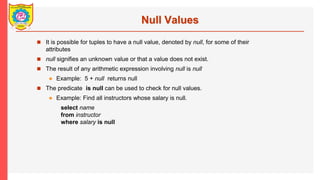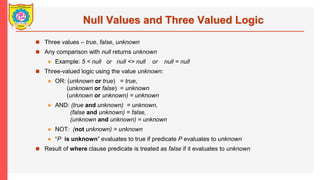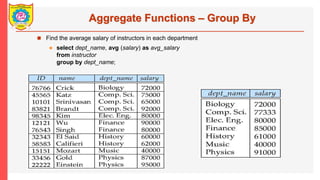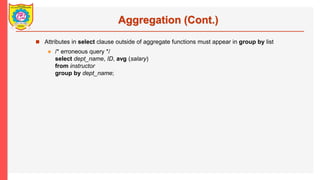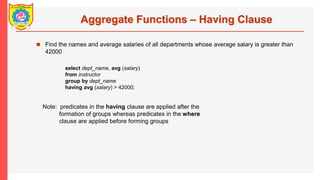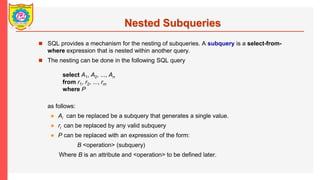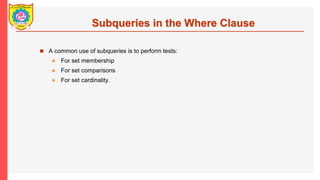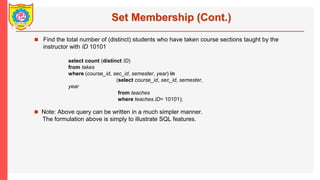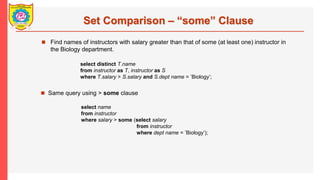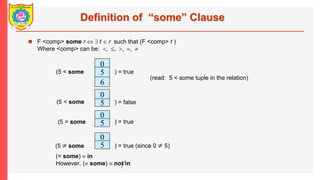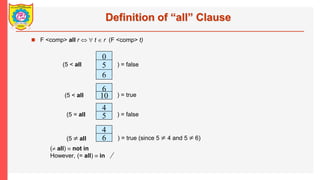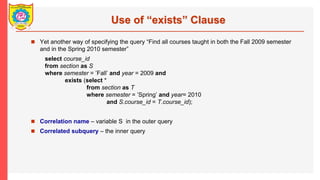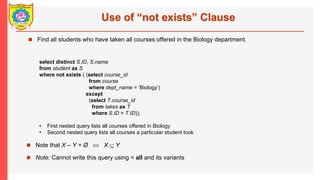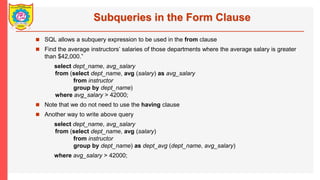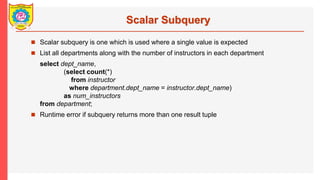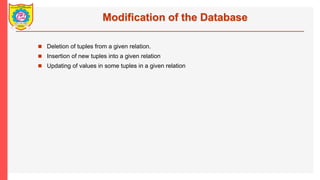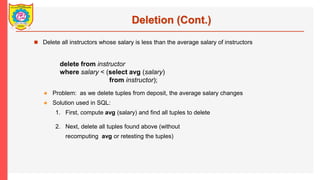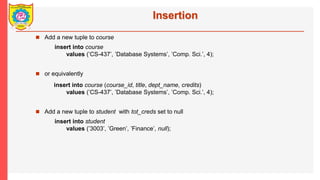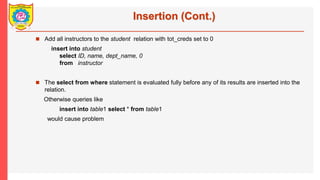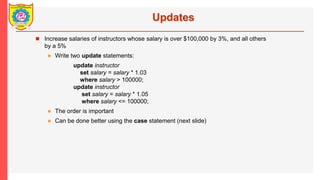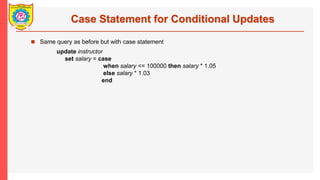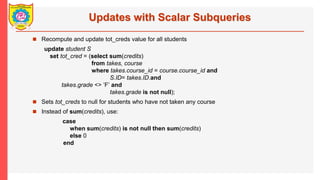UNIT 2 Structured query language commands
- 1. Database Management System (DBMS) Sanjivani Rural Education SocietyˇŻs Sanjivani College of Engineering, Kopargaon-423603 (An Autonomous Institute Affiliated to Savitribai Phule Pune University, Pune) NACC ˇ®AˇŻ Grade Accredited, ISO 9001:2015 Certified Department of Information Technology (NBAAccredited) SY IT Prof. Bhakti B Pawar Assistant Professor
- 2. UNIT-II PART B SQL
- 3. Outline ? Overview of The SQL Query Language ? Data Definition ? Basic Query Structure ? Additional Basic Operations ? Set Operations ? Null Values ? Aggregate Functions ? Nested Subqueries ? Modification of the Database
- 4. History ? IBM Sequel language developed as part of System R project at the IBM San Jose Research Laboratory ? Renamed Structured Query Language (SQL) ? ANSI and ISO standard SQL: ? SQL-86 ? SQL-89 ? SQL-92 ? SQL:1999 (language name became Y2K compliant!) ? SQL:2003 ? Commercial systems offer most, if not all, SQL-92 features, plus varying feature sets from later standards and special proprietary features. ? Not all examples here may work on your particular system.
- 5. Data Definition Language ? The schema for each relation. ? The domain of values associated with each attribute. ? Integrity constraints ? And as we will see later, also other information such as ? The set of indices to be maintained for each relations. ? Security and authorization information for each relation. ? The physical storage structure of each relation on disk. The SQL data-definition language (DDL) allows the specification of information about relations, including:
- 6. Domain Types in SQL ? char(n). Fixed length character string, with user-specified length n. ? varchar(n). Variable length character strings, with user-specified maximum length n. ? int. Integer (a finite subset of the integers that is machine-dependent). ? smallint. Small integer (a machine-dependent subset of the integer domain type). ? numeric(p,d). Fixed point number, with user-specified precision of p digits, with d digits to the right of decimal point. (ex., numeric(3,1), allows 44.5 to be stores exactly, but not 444.5 or 0.32) ? real, double precision. Floating point and double-precision floating point numbers, with machine-dependent precision. ? float(n). Floating point number, with user-specified precision of at least n digits. ? More are covered in Chapter 4.
- 7. Create Table Construct ? An SQL relation is defined using the create table command: create table r (A1 D1, A2 D2, ..., An Dn, (integrity-constraint1), ..., (integrity-constraintk)) ? r is the name of the relation ? each Ai is an attribute name in the schema of relation r ? Di is the data type of values in the domain of attribute Ai ? Example: create table instructor ( ID char(5), name varchar(20), dept_name varchar(20), salary numeric(8,2))
- 8. Integrity Constraints in Create Table Example: create table instructor ( ID char(5), name varchar(20) not null, dept_name varchar(20), salary numeric(8,2), primary key (ID), foreign key (dept_name) references department); ? not null ? primary key (A1, ..., An ) ? foreign key (Am, ..., An ) references r primary key declaration on an attribute automatically ensures not null
- 9. And a Few More Relation Definitions ? create table student ( ID varchar(5), name varchar(20) not null, dept_name varchar(20), tot_cred numeric(3,0), primary key (ID), foreign key (dept_name) references department); ? create table takes ( ID varchar(5), course_id varchar(8), sec_id varchar(8), semester varchar(6), year numeric(4,0), grade varchar(2), primary key (ID, course_id, sec_id, semester, year) , foreign key (ID) references student, foreign key (course_id, sec_id, semester, year) references section); ? Note: sec_id can be dropped from primary key above, to ensure a student cannot be registered for two sections of the same course in the same semester
- 10. And more still ? create table course ( course_id varchar(8), title varchar(50), dept_name varchar(20), credits numeric(2,0), primary key (course_id), foreign key (dept_name) references department);
- 11. Updates to tables ? Insert ? insert into instructor values (ˇ®10211ˇŻ, ˇŻSmithˇŻ, ˇŻBiologyˇŻ, 66000); ? Delete ? Remove all tuples from the student relation ? delete from student ? Drop Table ? drop table r ? Alter ? alter table r add A D ? where A is the name of the attribute to be added to relation r and D is the domain of A. ? All exiting tuples in the relation are assigned null as the value for the new attribute. ? alter table r drop A ? where A is the name of an attribute of relation r ? Dropping of attributes not supported by many databases.
- 12. Basic Query Structure ? A typical SQL query has the form: select A1, A2, ..., An from r1, r2, ..., rm where P ? Ai represents an attribute ? Ri represents a relation ? P is a predicate. ? The result of an SQL query is a relation.
- 13. The select Clause ? The select clause lists the attributes desired in the result of a query ? corresponds to the projection operation of the relational algebra ? Example: find the names of all instructors: select name from instructor ? NOTE: SQL names are case insensitive (i.e., you may use upper- or lower-case letters.) ? E.g., Name ˇÔ NAME ˇÔ name ? Some people use upper case wherever we use bold font.
- 14. The select Clause (Cont.) ? SQL allows duplicates in relations as well as in query results. ? To force the elimination of duplicates, insert the keyword distinct after select. ? Find the department names of all instructors, and remove duplicates select distinct dept_name from instructor ? The keyword all specifies that duplicates should not be removed. select all dept_name from instructor
- 15. The select Clause (Cont.) ? An asterisk in the select clause denotes ˇ°all attributesˇ± select * from instructor ? An attribute can be a literal with no from clause select ˇ®437ˇŻ ? Results is a table with one column and a single row with value ˇ°437ˇ± ? Can give the column a name using: select ˇ®437ˇŻ as FOO ? An attribute can be a literal with from clause select ˇ®AˇŻ from instructor ? Result is a table with one column and N rows (number of tuples in the instructors table), each row with value ˇ°Aˇ±
- 16. The select Clause (Cont.) ? The select clause can contain arithmetic expressions involving the operation, +, ¨C, ?, and /, and operating on constants or attributes of tuples. ? The query: select ID, name, salary/12 from instructor would return a relation that is the same as the instructor relation, except that the value of the attribute salary is divided by 12. ? Can rename ˇ°salary/12ˇ± using the as clause: select ID, name, salary/12 as monthly_salary
- 17. The where Clause ? The where clause specifies conditions that the result must satisfy ? Corresponds to the selection predicate of the relational algebra. ? To find all instructors in Comp. Sci. dept select name from instructor where dept_name = ˇ®Comp. Sci.' ? Comparison results can be combined using the logical connectives and, or, and not ? To find all instructors in Comp. Sci. dept with salary > 80000 select name from instructor where dept_name = ˇ®Comp. Sci.' and salary > 80000 ? Comparisons can be applied to results of arithmetic expressions.
- 18. The where Clause ? The where clause specifies conditions that the result must satisfy ? Corresponds to the selection predicate of the relational algebra. ? To find all instructors in Comp. Sci. dept select name from instructor where dept_name = ˇ®Comp. Sci.' ? Comparison results can be combined using the logical connectives and, or, and not ? To find all instructors in Comp. Sci. dept with salary > 80000 select name from instructor where dept_name = ˇ®Comp. Sci.' and salary > 80000 ? Comparisons can be applied to results of arithmetic expressions.
- 19. The from Clause ? The from clause lists the relations involved in the query ? Corresponds to the Cartesian product operation of the relational algebra. ? Find the Cartesian product instructor X teaches select ? from instructor, teaches ? generates every possible instructor ¨C teaches pair, with all attributes from both relations. ? For common attributes (e.g., ID), the attributes in the resulting table are renamed using the relation name (e.g., instructor.ID) ? Cartesian product not very useful directly, but useful combined with where-clause condition (selection operation in relational algebra).
- 21. Examples ? Find the names of all instructors who have taught some course and the course_id ? select name, course_id from instructor , teaches where instructor.ID = teaches.ID ? Find the names of all instructors in the Art department who have taught some course and the course_id ? select name, course_id from instructor , teaches where instructor.ID = teaches.ID and instructor. dept_name = ˇ®ArtˇŻ
- 22. The Rename Operation ? The SQL allows renaming relations and attributes using the as clause: old-name as new-name ? Find the names of all instructors who have a higher salary than some instructor in ˇ®Comp. SciˇŻ. ? select distinct T.name from instructor as T, instructor as S where T.salary > S.salary and S.dept_name = ˇ®Comp. Sci.ˇŻ ? Keyword as is optional and may be omitted instructor as T ˇÔ instructor T
- 23. Cartesian Product Example ? Relation emp-super ? Find the supervisor of ˇ°Bobˇ± ? Find the supervisor of the supervisor of ˇ°Bobˇ± ? Find ALL the supervisors (direct and indirect) of ˇ°Bob person supervisor Bob Alice Mary Susan Alice David David Mary
- 24. String Operations ? SQL includes a string-matching operator for comparisons on character strings. The operator like uses patterns that are described using two special characters: ? percent ( % ). The % character matches any substring. ? underscore ( _ ). The _ character matches any character. ? Find the names of all instructors whose name includes the substring ˇ°darˇ±. select name from instructor where name like '%dar%' ? Match the string ˇ°100%ˇ± like ˇ®100 %' escape '' in that above we use backslash () as the escape character.
- 25. String Operations ? SQL includes a string-matching operator for comparisons on character strings. The operator like uses patterns that are described using two special characters: ? percent ( % ). The % character matches any substring. ? underscore ( _ ). The _ character matches any character. ? Find the names of all instructors whose name includes the substring ˇ°darˇ±. select name from instructor where name like '%dar%' ? Match the string ˇ°100%ˇ± like ˇ®100 %' escape '' in that above we use backslash () as the escape character.
- 26. String Operations (Cont.) ? Patterns are case sensitive. ? Pattern matching examples: ? ˇ®Intro%ˇŻ matches any string beginning with ˇ°Introˇ±. ? ˇ®%Comp%ˇŻ matches any string containing ˇ°Compˇ± as a substring. ? ˇ®_ _ _ˇŻ matches any string of exactly three characters. ? ˇ®_ _ _ %ˇŻ matches any string of at least three characters. ? SQL supports a variety of string operations such as ? concatenation (using ˇ°||ˇ±) ? converting from upper to lower case (and vice versa) ? finding string length, extracting substrings, etc.
- 27. Ordering the Display of Tuples ? List in alphabetic order the names of all instructors select distinct name from instructor order by name ? We may specify desc for descending order or asc for ascending order, for each attribute; ascending order is the default. ? Example: order by name desc ? Can sort on multiple attributes ? Example: order by dept_name, name
- 28. Where Clause Predicates ? SQL includes a between comparison operator ? Example: Find the names of all instructors with salary between $90,000 and $100,000 (that is, ? $90,000 and ? $100,000) ? select name from instructor where salary between 90000 and 100000 ? Tuple comparison ? select name, course_id from instructor, teaches where (instructor.ID, dept_name) = (teaches.ID, ˇŻBiologyˇŻ);
- 29. Duplicates ? In relations with duplicates, SQL can define how many copies of tuples appear in the result. ? Multiset versions of some of the relational algebra operators ¨C given multiset relations r1 and r2: 1. ?? (r1): If there are c1 copies of tuple t1 in r1, and t1 satisfies selections ??,, then there are c1 copies of t1 in ?? (r1). 2. ?A (r ): For each copy of tuple t1 in r1, there is a copy of tuple ?A (t1) in ?A (r1) where ?A (t1) denotes the projection of the single tuple t1. 3. r1 x r2: If there are c1 copies of tuple t1 in r1 and c2 copies of tuple t2 in r2, there are c1 x c2 copies of the tuple t1. t2 in r1 x r2
- 30. Duplicates (Cont.) ? Example: Suppose multiset relations r1 (A, B) and r2 (C) are as follows: r1 = {(1, a) (2,a)} r2 = {(2), (3), (3)} ? Then ?B(r1) would be {(a), (a)}, while ?B(r1) x r2 would be {(a,2), (a,2), (a,3), (a,3), (a,3), (a,3)} ? SQL duplicate semantics: select A1,, A2, ..., An from r1, r2, ..., rm where P is equivalent to the multiset version of the expression:
- 31. Set Operations ? Find courses that ran in Fall 2009 or in Spring 2010 ? Find courses that ran in Fall 2009 but not in Spring 2010 (select course_id from section where sem = ˇ®FallˇŻ and year = 2009) union (select course_id from section where sem = ˇ®SpringˇŻ and year = 2010) ? Find courses that ran in Fall 2009 and in Spring 2010 (select course_id from section where sem = ˇ®FallˇŻ and year = 2009) intersect (select course_id from section where sem = ˇ®SpringˇŻ and year = 2010) (select course_id from section where sem = ˇ®FallˇŻ and year = 2009) except (select course_id from section where sem = ˇ®SpringˇŻ and year = 2010)
- 32. Set Operations (Cont.) ? Find the salaries of all instructors that are less than the largest salary. ? select distinct T.salary from instructor as T, instructor as S where T.salary < S.salary ? Find all the salaries of all instructors ? select distinct salary from instructor ? Find the largest salary of all instructors. ? (select ˇ°second queryˇ± ) except (select ˇ°first queryˇ±)
- 33. Set Operations (Cont.) ? Set operations union, intersect, and except ? Each of the above operations automatically eliminates duplicates ? To retain all duplicates use the corresponding multiset versions union all, intersect all and except all. ? Suppose a tuple occurs m times in r and n times in s, then, it occurs: ? m + n times in r union all s ? min(m,n) times in r intersect all s ? max(0, m ¨C n) times in r except all s
- 34. Null Values ? It is possible for tuples to have a null value, denoted by null, for some of their attributes ? null signifies an unknown value or that a value does not exist. ? The result of any arithmetic expression involving null is null ? Example: 5 + null returns null ? The predicate is null can be used to check for null values. ? Example: Find all instructors whose salary is null. select name from instructor where salary is null
- 35. Null Values and Three Valued Logic ? Three values ¨C true, false, unknown ? Any comparison with null returns unknown ? Example: 5 < null or null <> null or null = null ? Three-valued logic using the value unknown: ? OR: (unknown or true) = true, (unknown or false) = unknown (unknown or unknown) = unknown ? AND: (true and unknown) = unknown, (false and unknown) = false, (unknown and unknown) = unknown ? NOT: (not unknown) = unknown ? ˇ°P is unknownˇ± evaluates to true if predicate P evaluates to unknown ? Result of where clause predicate is treated as false if it evaluates to unknown
- 36. Aggregate Functions ? These functions operate on the multiset of values of a column of a relation, and return a value avg: average value min: minimum value max: maximum value sum: sum of values count: number of values
- 37. Aggregate Functions (Cont.) ? Find the average salary of instructors in the Computer Science department ? select avg (salary) from instructor where dept_name= ˇŻComp. Sci.ˇŻ; ? Find the total number of instructors who teach a course in the Spring 2010 semester ? select count (distinct ID) from teaches where semester = ˇŻSpringˇŻ and year = 2010; ? Find the number of tuples in the course relation ? select count (*) from course;
- 38. Aggregate Functions ¨C Group By ? Find the average salary of instructors in each department ? select dept_name, avg (salary) as avg_salary from instructor group by dept_name;
- 39. Aggregation (Cont.) ? Attributes in select clause outside of aggregate functions must appear in group by list ? /* erroneous query */ select dept_name, ID, avg (salary) from instructor group by dept_name;
- 40. Aggregate Functions ¨C Having Clause ? Find the names and average salaries of all departments whose average salary is greater than 42000 Note: predicates in the having clause are applied after the formation of groups whereas predicates in the where clause are applied before forming groups select dept_name, avg (salary) from instructor group by dept_name having avg (salary) > 42000;
- 41. Null Values and Aggregates ? Total all salaries select sum (salary ) from instructor ? Above statement ignores null amounts ? Result is null if there is no non-null amount ? All aggregate operations except count(*) ignore tuples with null values on the aggregated attributes ? What if collection has only null values? ? count returns 0 ? all other aggregates return null
- 42. Nested Subqueries ? SQL provides a mechanism for the nesting of subqueries. A subquery is a select-from- where expression that is nested within another query. ? The nesting can be done in the following SQL query select A1, A2, ..., An from r1, r2, ..., rm where P as follows: ? Ai can be replaced be a subquery that generates a single value. ? ri can be replaced by any valid subquery ? P can be replaced with an expression of the form: B <operation> (subquery) Where B is an attribute and <operation> to be defined later.
- 43. Subqueries in the Where Clause ? A common use of subqueries is to perform tests: ? For set membership ? For set comparisons ? For set cardinality.
- 44. Set Membership ? Find courses offered in Fall 2009 and in Spring 2010 ? Find courses offered in Fall 2009 but not in Spring 2010 select distinct course_id from section where semester = ˇŻFallˇŻ and year= 2009 and course_id in (select course_id from section where semester = ˇŻSpringˇŻ and year= 2010); select distinct course_id from section where semester = ˇŻFallˇŻ and year= 2009 and course_id not in (select course_id from section where semester = ˇŻSpringˇŻ and year= 2010);
- 45. Set Membership (Cont.) ? Find the total number of (distinct) students who have taken course sections taught by the instructor with ID 10101 ? Note: Above query can be written in a much simpler manner. The formulation above is simply to illustrate SQL features. select count (distinct ID) from takes where (course_id, sec_id, semester, year) in (select course_id, sec_id, semester, year from teaches where teaches.ID= 10101);
- 46. Set Comparison ¨C ˇ°someˇ± Clause ? Find names of instructors with salary greater than that of some (at least one) instructor in the Biology department. ? Same query using > some clause select name from instructor where salary > some (select salary from instructor where dept name = ˇŻBiologyˇŻ); select distinct T.name from instructor as T, instructor as S where T.salary > S.salary and S.dept name = ˇŻBiologyˇŻ;
- 47. Definition of ˇ°someˇ± Clause ? F <comp> some r ????t ? r such that (F <comp> t ) Where <comp> can be: ?? ???? ??? ??? ? 0 5 6 (5 < some ) = true 0 5 0 ) = false 5 0 5 (5 ? some ) = true (since 0 ? 5) (read: 5 < some tuple in the relation) (5 < some ) = true (5 = some (= some) ? in However, (? some) ? not in
- 48. Set Comparison ¨C ˇ°allˇ± Clause ? Find the names of all instructors whose salary is greater than the salary of all instructors in the Biology department. select name from instructor where salary > all (select salary from instructor where dept name = ˇŻBiologyˇŻ);
- 49. Definition of ˇ°allˇ± Clause ? F <comp> all r ????t ? r (F <comp> t) 0 5 6 (5 < all ) = false 6 10 4 ) = true 5 4 6 (5 ? all ) = true (since 5 ? 4 and 5 ? 6) (5 < all ) = false (5 = all (? all) ? not in However, (= all) ? in
- 50. Test for Empty Relations ? The exists construct returns the value true if the argument subquery is nonempty. ? exists r ?? r ? ? ? not exists r ?? r = ?
- 51. Use of ˇ°existsˇ± Clause ? Yet another way of specifying the query ˇ°Find all courses taught in both the Fall 2009 semester and in the Spring 2010 semesterˇ± select course_id from section as S where semester = ˇŻFallˇŻ and year = 2009 and exists (select * from section as T where semester = ˇŻSpringˇŻ and year= 2010 and S.course_id = T.course_id); ? Correlation name ¨C variable S in the outer query ? Correlated subquery ¨C the inner query
- 52. Use of ˇ°not existsˇ± Clause ? Find all students who have taken all courses offered in the Biology department. select distinct S.ID, S.name from student as S where not exists ( (select course_id from course where dept_name = ˇŻBiologyˇŻ) except (select T.course_id from takes as T where S.ID = T.ID)); ? First nested query lists all courses offered in Biology ? Second nested query lists all courses a particular student took ? Note that X ¨C Y = ? ? X?? Y ? Note: Cannot write this query using = all and its variants
- 53. Test for Absence of Duplicate Tuples ? The unique construct tests whether a subquery has any duplicate tuples in its result. ? The unique construct evaluates to ˇ°trueˇ± if a given subquery contains no duplicates . ? Find all courses that were offered at most once in 2009 select T.course_id from course as T where unique (select R.course_id from section as R where T.course_id= R.course_id and R.year = 2009);
- 54. Subqueries in the Form Clause ? SQL allows a subquery expression to be used in the from clause ? Find the average instructorsˇŻ salaries of those departments where the average salary is greater than $42,000.ˇ± select dept_name, avg_salary from (select dept_name, avg (salary) as avg_salary from instructor group by dept_name) where avg_salary > 42000; ? Note that we do not need to use the having clause ? Another way to write above query select dept_name, avg_salary from (select dept_name, avg (salary) from instructor group by dept_name) as dept_avg (dept_name, avg_salary) where avg_salary > 42000;
- 55. With Clause ? The with clause provides a way of defining a temporary relation whose definition is available only to the query in which the with clause occurs. ? Find all departments with the maximum budget with max_budget (value) as (select max(budget) from department) select department.name from department, max_budget where department.budget = max_budget.value;
- 56. Complex Queries using With Clause ? Find all departments where the total salary is greater than the average of the total salary at all departments with dept _total (dept_name, value) as (select dept_name, sum(salary) from instructor group by dept_name), dept_total_avg(value) as (select avg(value) from dept_total) select dept_name from dept_total, dept_total_avg where dept_total.value > dept_total_avg.value;
- 57. Scalar Subquery ? Scalar subquery is one which is used where a single value is expected ? List all departments along with the number of instructors in each department select dept_name, (select count(*) from instructor where department.dept_name = instructor.dept_name) as num_instructors from department; ? Runtime error if subquery returns more than one result tuple
- 58. Modification of the Database ? Deletion of tuples from a given relation. ? Insertion of new tuples into a given relation ? Updating of values in some tuples in a given relation
- 59. Deletion ? Delete all instructors delete from instructor ? Delete all instructors from the Finance department delete from instructor where dept_name= ˇŻFinanceˇŻ; ? Delete all tuples in the instructor relation for those instructors associated with a department located in the Watson building. delete from instructor where dept name in (select dept name from department where building = ˇŻWatsonˇŻ);
- 60. Deletion (Cont.) ? Delete all instructors whose salary is less than the average salary of instructors delete from instructor where salary < (select avg (salary) from instructor); ? Problem: as we delete tuples from deposit, the average salary changes ? Solution used in SQL: 1. First, compute avg (salary) and find all tuples to delete 2. Next, delete all tuples found above (without recomputing avg or retesting the tuples)
- 61. Insertion ? Add a new tuple to course insert into course values (ˇŻCS-437ˇŻ, ˇŻDatabase SystemsˇŻ, ˇŻComp. Sci.ˇŻ, 4); ? or equivalently insert into course (course_id, title, dept_name, credits) values (ˇŻCS-437ˇŻ, ˇŻDatabase SystemsˇŻ, ˇŻComp. Sci.ˇŻ, 4); ? Add a new tuple to student with tot_creds set to null insert into student values (ˇŻ3003ˇŻ, ˇŻGreenˇŻ, ˇŻFinanceˇŻ, null);
- 62. Insertion (Cont.) ? Add all instructors to the student relation with tot_creds set to 0 insert into student select ID, name, dept_name, 0 from instructor ? The select from where statement is evaluated fully before any of its results are inserted into the relation. Otherwise queries like insert into table1 select * from table1 would cause problem
- 63. Updates ? Increase salaries of instructors whose salary is over $100,000 by 3%, and all others by a 5% ? Write two update statements: update instructor set salary = salary * 1.03 where salary > 100000; update instructor set salary = salary * 1.05 where salary <= 100000; ? The order is important ? Can be done better using the case statement (next slide)
- 64. Case Statement for Conditional Updates ? Same query as before but with case statement update instructor set salary = case when salary <= 100000 then salary * 1.05 else salary * 1.03 end
- 65. Updates with Scalar Subqueries ? Recompute and update tot_creds value for all students update student S set tot_cred = (select sum(credits) from takes, course where takes.course_id = course.course_id and S.ID= takes.ID.and takes.grade <> ˇŻFˇŻ and takes.grade is not null); ? Sets tot_creds to null for students who have not taken any course ? Instead of sum(credits), use: case when sum(credits) is not null then sum(credits) else 0 end
